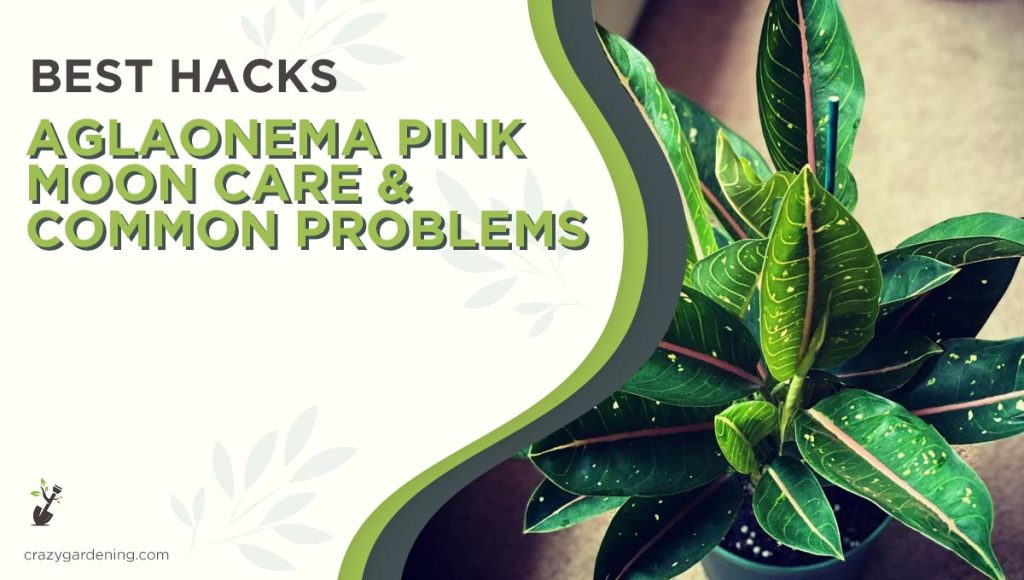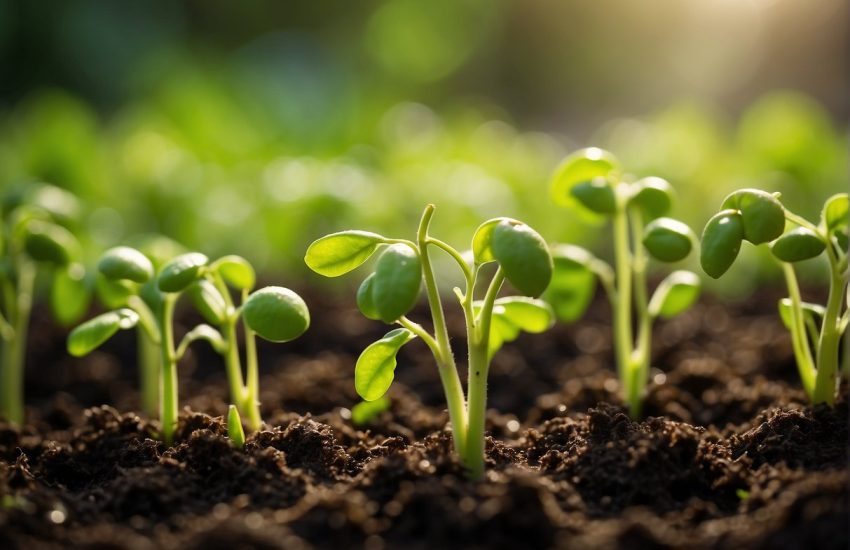How to Care for Aglaonema Pink Moon (Chinese Evergreen 2025)
Did you know the Aglaonema pink moon is a beautiful and easy-to-care-for houseplant? It’s one of my favorites! In this post, I’ll go over the basics of how to care for an Aglaonema pink moon, including tips on watering, sunlight, and fertilizing.
I’ll also touch on some common problems that can occur with this plant and how to troubleshoot them. So, if you’re thinking about adding an Aglaonema pink moon to your indoor garden, read on!

What is the Aglaonema Pink Moon Chinese Evergreen Plant?
**Family**: Araceae
**Genus**: Aglaonemateae
**Cultivar**: Pink Moon
The Aglaonema ‘Pink Moon’ plant is a stunning specimen that thrives in low-light environments and requires little attention from the plant owner. The color is, of course, what sets this plant apart from others and makes it so highly sought. It is fairly slow growing and prefers to be let to dry out between watering, as is the case with all Aglaonemas.
All of the plants in this genus are collectively referred to by their common name, the Chinese evergreen plant. The majority of them are appropriate for use as indoor ornamental plantations due to their low maintenance requirements as well as their colorful and attractive leaves.
What are the Features of Aglaonema Pink Moon?
Air Purification
All Aglaonemas have this ability to some extent, but ‘Pink Moon’ is especially good at it.
Size
When fully mature, the plant grows a 1- to 2-foot-tall compact shrub.
Leaves
The leaves are the most noticeable part of the plant. A fully developed leaf can extend to cover up to two-thirds of the plant’s total surface area.
Flower
Like its relatives, this one blooms with lily-like flowers that are more pink than white. This is because these blossoms thrive in the warm weather of spring and summer.
Low Light
It is one of the few plants that can tolerate very low light conditions, making it ideal for indoor cultivation.
How to Care for Aglaonema Pink Moon?
There are many types of flower like hoya rotundiflora](https://plantnative.org/gardening/hoya-rotundiflora-care/), [hoya callistophylla, and more but care is always an important topic in all the cases.
Soil
Soil with good drainage is essential for this member of the family, as it is for all members of the family. Feel free to utilize the standard houseplant combo. Adding perlite or sand to a peat-based mixture is another way to improve drainage.
Water
This plant is not too fussy when it comes to watering. It prefers to be allowed to dry out between watering, but will also tolerate being kept a little moister. I would recommend watering every 7-10 days or when the upper half of the soil is dry.
Light
This plant does best in indirect sun or fluorescent light. It can tolerate lower light levels but may become leggy if not given enough light.
Humidity
This plant loves high humidity, but can also tolerate lower levels. If you live in a particularly dry climate, you may want to consider setting your Aglaonema pink moon on a pebble tray or misting it occasionally.
Fertilizers
Fertilizing is not necessary for this plant, but if you choose to do so, use a mild concentration of fertilizer in spring and summer. I would recommend using a liquid fertilizer or one that is specially formulated for houseplants.
Temperature
These folks prefer toasty environments. The optimal range for this genus is anywhere between 65- and 80 degrees Fahrenheit.
They aren’t very cold or frost resistant. Problems, such as discoloration of the foliage, may appear if the temperature drops below 60 degrees Fahrenheit. Furthermore, the plant could perish if it freezes. As a result, remember to bring the outdoor ones inside to a toasty environment.
Propagation
You can divide the plant’s leaves and roots and replant them in the spring or summer to start new plants. Aerial root cuttings and divisions made during transplantation are also viable methods of reproduction.
There are two ways to start new Aglaonema Pink Moon plants: when the rosette stage of growth finishes and a conspicuous branch arises, or when the stalk naturally branches (particularly the modest one is prone to this).
A single apical stem can be removed, and the remainder of the plant can be sliced into pieces between 8 and 10 cm in length. Keeping the leaves on cuttings is recommended. It takes a month for roots to grow from cuttings after they have been pulverized with charcoal, dried for 24 hours, and then buried 4-6 centimeters in moist sand with peat at a temperature of 21-25 C.
Rooting can be accomplished in two to three weeks when employing bottom heating in miniature greenhouses. Aglaonema pruning is best done in the spring or summer if you don’t have access to a heated greenhouse. These cuttings are rooted and then planted in a medium designed for full-grown plants.
Common Problems with Aglaonema Pink Moon
Yellowing leaves
One of the most common problems with this plant is yellowing leaves. This can be caused by too much sun, over-watering, or lack of humidity. If you see your plant’s leaves start to turn yellow, adjust its light and water requirements accordingly.
Brown Tips
Another common problem is brown tips on the leaves. This is usually caused by too much fluoride in the water or not enough humidity. If you live in an area with hard water, you may want to consider using distilled or filtered water for your plant. You can also increase the humidity around your plant by setting it on a pebble tray or misting it occasionally.
Leggy growth
If your Aglaonema pink moon is growing too tall and leggy, it’s probably not getting enough light. Move it to a brighter spot and see if that helps. If not, you may need to give it supplemental lighting in the form of fluorescent bulbs or grow lights.
Pests
This plant is relatively resistant to pests, but mealybugsand spider mites can be a problem. If you see any pests on your plant, treat them with an appropriate insecticide or miticide.
Diseases
Aglaonema pink moons are relatively resistant to diseases, but they can be susceptible to root rot if they are over-watered. If you think your plant has root rot, check the roots for signs of decay. If they are mushy or black, you will need to replant your Aglaonema in fresh, well-draining soil.
Conclusion
Aglaonema Pink Moon is an Asian Aroid. This bushy shrub is 2 feet tall. Long, dark-green, meaty leaves have a pink vein that contrasts with white splashes. Plants can survive shade or low light.
It’s great for both homes and businesses. They can grow outside in mild climates. Low-maintenance air purifiers are toxic to people. Keep youngsters and pets away from your pink moon plant. Be sure to give it enough light and water, and you’ll have a happy, healthy plant for years to come. Thanks for reading!
FAQs
Question
How often should Aglaonema be watered?
Answer
No, Aglaonema does not like direct sunlight. It prefers bright, indirect light, or low light. If you live in a very sunny climate, you may need to give your plant some supplemental lighting in the form of fluorescent bulbs or grow lights.
Question
Does Aglaonema like direct sunlight?
Answer
If your Aglaonema is growing too tall and leggy, it’s probably not getting enough light. Move it to a brighter spot and see if that helps. If not, you may need to give it supplemental lighting in the form of fluorescent bulbs or grow lights. Pruning can also help encourage new growth. Prune back any leggy or overgrown growth in the spring or summer. This will encourage your plant to put out new growth.
Question
How can I increase my Aglaonema growth?
Answer
During dry spells, the Aglaonema plant can conserve water in its stalks. The plant can decay if the soil is too wet and the stalks are too full of water. Watering should be withheld, the soil should be aerated (or in extreme situations replaced), and any rotten stalks should be removed.
Question
How do I keep my Aglaonema healthy?
Answer
Yes, pink aglaonema is an indoor plant that is often grown for its attractive foliage and low maintenance requirements. Pink aglaonema is a type of plant in the Araceae family and is native to tropical regions of Asia. It is known for its colorful, variegated leaves, which can range in color from pale pink to deep red or purple.
Question
How do you take care of pink aglaonema?
Answer
Pink aglaonema plants prefer bright, indirect light and should be watered regularly to keep the soil evenly moist. They are generally easy to care for and are a popular choice for indoor gardens and office spaces.
Question
Does aglaonema grow fast?
Answer
Aglaonema is generally a slow-growing plant, with most varieties taking several years to reach their full size. However, some varieties of aglaonema may grow more quickly than others, depending on the specific species and the growing conditions. Providing the plant with optimal growing conditions can help it to grow more quickly, but it is generally not a fast-growing plant.
Question
Why is my pink aglaonema dying?
Answer
>- There are several possible reasons why a pink aglaonema plant may be dying. Some common causes of plant death include: 1. Overwatering 2. Underwatering 3. Poor lighting 4. Pest infestations 5. Nutrient deficiencies If you are unsure of the cause of your pink aglaonema plant’s death, it is a good idea to consult a professional or refer to the plant’s care instructions.

